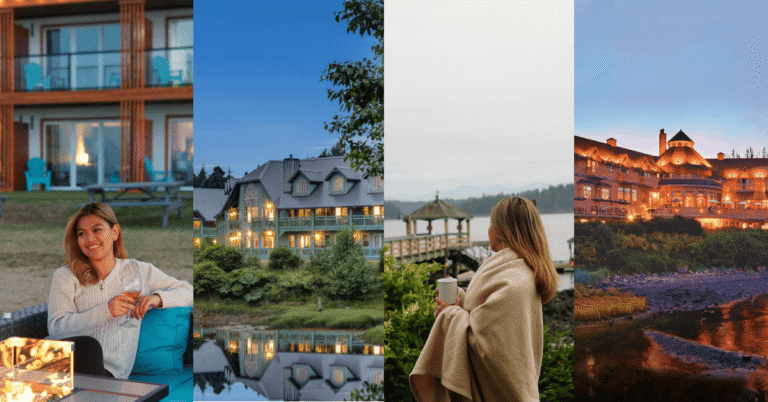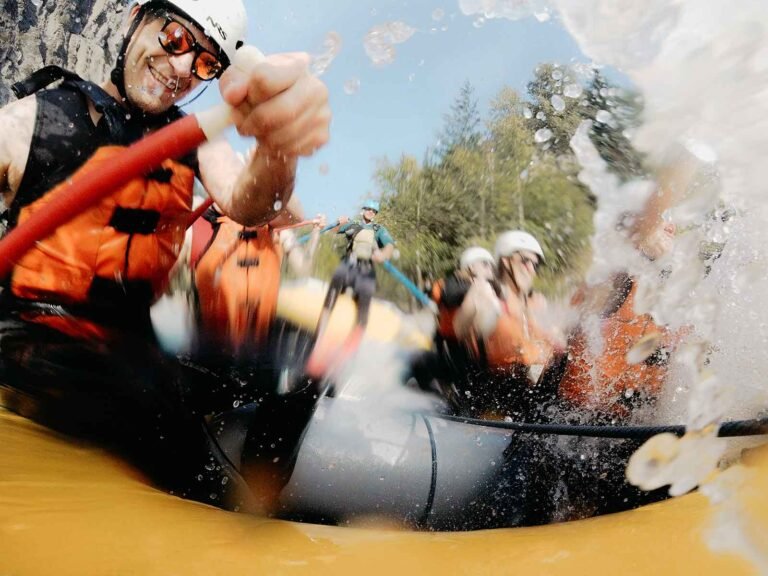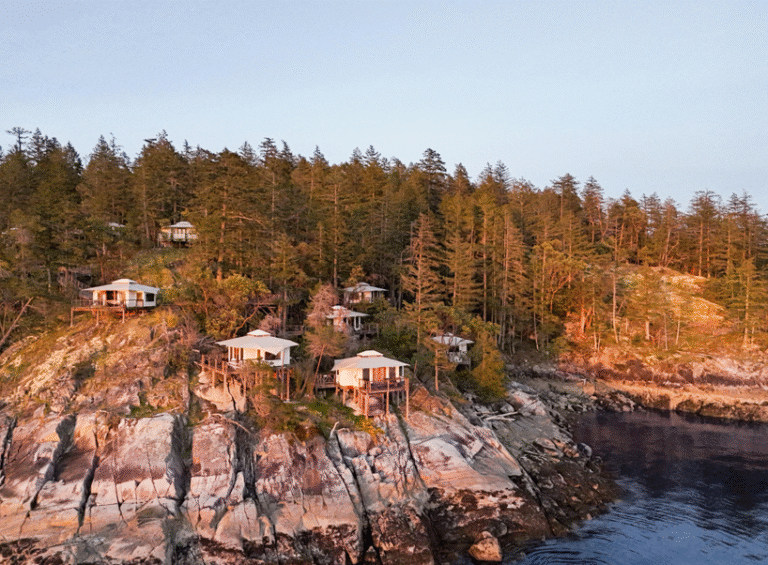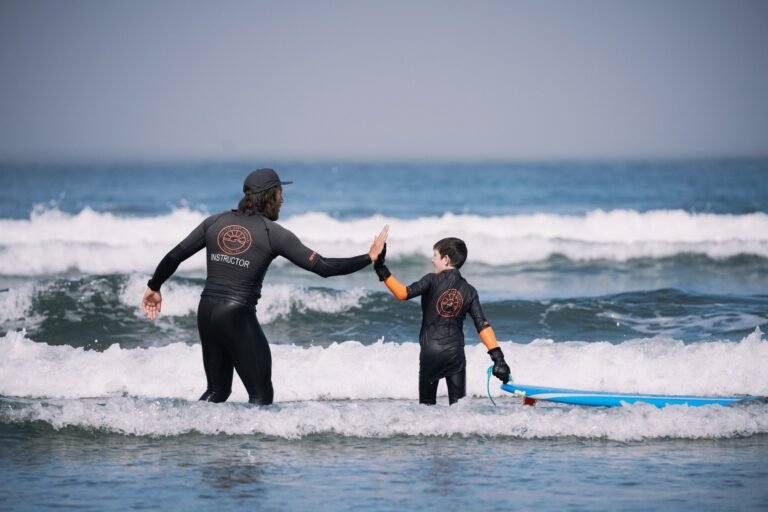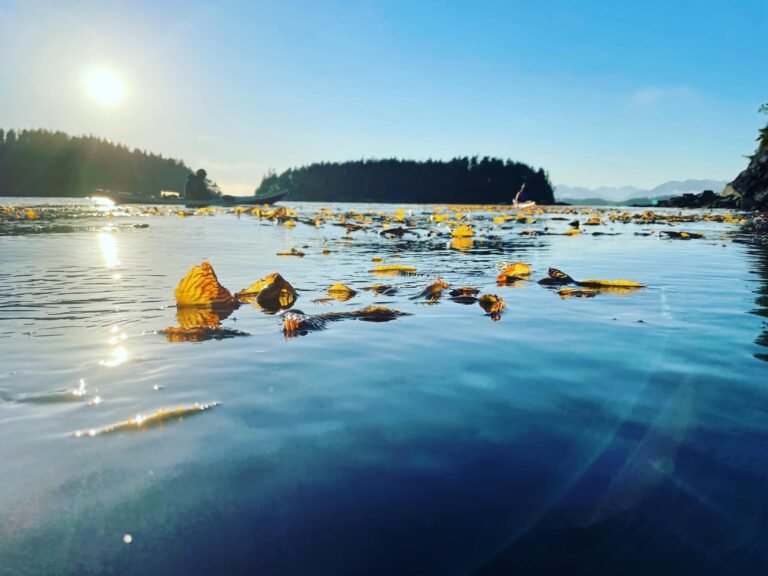North Fraser Valley
If you’re a mountain biker looking for an aerobic workout, head for trails on Burke Mountain (more properly called Mount Burke) in Coquitlam. You’ll be in good gearhead company here. The mountain is a network of old skidder trails and logging roads and some more recent singletrack, including the in-your-face Sawblade, which is comparable to even the nastiest technical riding trails on the North Shore. To find the trailhead, from Hwy 7 go north on Coast Meridian Road. Instead of heading for the PoCo trail (see Cycling section) continue on almost to the end of Coast Meridian and turn right on Harper. Follow Harper as it climbs Mount Burke. Park beside a gate next to the Coquitlam Gun Club and begin pumping uphill from here.
Follow Woodland Walk Trail on your left. It soon divides, with the beauty-view Coquitlam Lakeview Trail heading off to the right. Both Woodland and the Lakeview trail are crossed in several places by the rough – and renowned – Sawblade Trail. An alternate route is the Galloway Trail. To find it, stay right at all turns as you cycle east from the gun club. Watch for the Galloway trailhead on your right before the road passes beneath some power lines. Although the trail begins with a steep descent, it soon moderates to an intermediate singletrack with a sweet drop to paved Galloway Road. Turn right on Galloway, which leads back to Harper.
Looking north from Grant Narrows Regional Park on Pitt Lake’s south shore, visitors peer out at the long lake whose surface is tightly hemmed in by the surrounding mountains: Burke to the west, Alouette and Blanshard to the east. If you arrange a boat ride up the lake, you enter a much less visited region that attracts mountain bikers as well as anglers, hikers, and paddlers.
The J. S. Jones Timber Company has a log-sorting yard beside the wharf where you land. Head north from here along the Upper Pitt River Logging Road. It’s a relief to trade the throbbing boat engine for the whistle of wind through the vents in your helmet. The voice of the Pitt River sings through the woods to the west of the road as it flows south from its headwaters in Garibaldi Provincial Park, 30 miles (50 km) north of the lake. The Mamquam Glacier‘s massive wall of snow and ice stands like a fortress on the skyline when seen from here. Olive-coloured moss cloaks the arms of the sturdy vine maples, some of the largest in the Lower Mainland, that line the road. Solitary Sitka spruce rise from the wetland of Red Slough to the east.
Knobby tires come in handy as you cycle the rough logging roads that parallel both sides of the river. The road divides at marker kilometre 5 on the Pitt River Road. If you follow the east side, the road leads past the small settlement of Alvin, where these days only a logging-company caretaker is in permanent residence. Alvin lies about 2 miles (3 km) north of the road’s divide. A short distance beyond Alvin is one of the oldest fish hatcheries in the province, run by members of the Katzie band. It’s worth a stop here just to see the waters of Corbold Creek charge through a narrow canyon before spilling onto the gravel spawning bar below. Once the snow leaves the ground, cyclists can enjoy a 10-mile (16-km) ride north of the hatchery to the Pitt River wilderness hot springs.
On the opposite side of the Upper Pitt River from the fish hatchery lies the narrow Boise Valley. To make your way there, follow the west branch of the logging road where it divides at the ‘kilometre 5’ mark. Cross a nearby log bridge over the Upper Pitt and head north. The Boise Logging Road is much more challenging than its counterpart on the opposite side of the valley. This is where conditioning counts, particularly where the road climbs for about 2 miles (3 km) towards the Cougar Lakes. Follow the road another 5 miles (8 km) to its end, at which point a hiking trail through the Boise Valley section of Pinecone Burke Provincial Park begins.
There are two good mountain-bike rides for the taking in Golden Ears Provincial Park. A paved road leads west from the parking lot at Mike Lake into the UBC Research Forest. Although bikes are not allowed in the forest, they are permitted on the rough Alouette Mountain fire access trail (12 miles/20 km return) that begins from the paved research forest road a short distance north of Mike Lake. This is a quiet, forested stretch, far removed from the crowds at nearby Alouette Lake. A good intermediate hiking trail that intersects with the Alouette Mountain fire access trail at several points leads from Mike Lake to Lake Beautiful and the summit of Alouette Mountain (12 miles/20 km return). Lake Beautiful is located at approximately the halfway point between Mike Lake and the top of Alouette Mountain itself. The diminutive, lily-pad-covered lake is a bit of a letdown, overgrown and sheltered as it is by the surrounding virgin forest of mountain hemlock and yellow cedar. Uphill from Lake Beautiful the trail becomes all but impassable to mountain bikes. The thrilling descent down the Alouette Mountain fire access trail takes half the time. The other mountain-bike trail in Golden Ears is the East Canyon Trail, which begins from the Gold Creek parking lot.
Blue Mountain, in the municipality of Maple Ridge, is a victim of its own popularity. The soft loam that forms much of the area’s trails has been severely rutted by years of motorbiking. This Forest Service area is still a great place to ride for the technically proficient. For every rutted route, there’s a soft, fresh trail to be had. One of the more popular trails is the Humphill Downhill, but with the number of side trails, it might take you a while to figure it out. It’s not a long ride, though, and once you’ve found the right line, you’ll want to ride it a few more times, just for the thrill of it. Another popular trail is the Muzz, complete with wooden sidewalks, or corduroys, to get you over the really muddy sections. To reach Blue Mountain, travel east of Maple Ridge on Dewdney Trunk Road, then turn north on either 256th Street or McNutt Road. Trails begin from the gates at the end of each. Detailed descriptions of all rides, including Humphill Downhill and Muzz, are included in Mountain Biking British Columbia by Darrin Polischuk.
As Dewdney Trunk Road heads northwest of Mission, watch for the Forest Service recreation trails on Bear Mountain and Red Mountain. Signs appear as the road nears Stave Lake’s Ruskin Dam. Don’t park on Rod ‘n Gun Club property, even though you have to bike through it to get to Red Mountain, a loop with some side trails to explore, depending on your mood. Red Mountain is the site of an annual race, and the trails are fast yet also moderate. Not so with the companion Bear Mountain, just across the road, which is a bear of a ride. But even it can’t compare to the Mount Mary Ann Trails, near Westminster Abbey. Park in the Fraser River Heritage Regional Park, just off Stave Lake Road on Fifth Avenue in Mission. (You might want to get the Benedictines to administer last rites before you make any attempt on these. This is technical riding at its most difficult: fast, steep, and out of control.)
Miles of old logging and hydro power roads run through the hills surrounding Hicks and Deer Lakes in Sasquatch Provincial Park, perfect for a moderately challenging but lengthy mountain-bike ride. Bear Mountain (not to be confused with the other Bear Mountain near Stave Lake) lies just outside the park to the south. Take Rockwell Drive from Harrison Hot Springs around the east side of the lake, almost to the Green Point picnic area. As Rockwell climbs a steep hill, watch for a rough side road that leads off to the right. This is where the Bear Mountain Trail begins. Park here. A series of old roads climbs from the Bear Mountain trailhead beside Harrison Lake for almost 6 miles (9 km) with an elevation gain of 3,300 ft. (1000 m). Head uphill on an old road that skirts a fenced mining-company property and joins an active logging road. You’ll have to bike-and-hike in places, or stash your two-wheel chariot for a final ascent on foot. Catch your breath as you drink in panoramic views of the Fraser Valley and peaks to the south, with mountain scenery on the other three sides.
The folks over at Hemlock Valley have opened their clear-cut hillsides in the summer to mountain bikes. Come ride the trails, but on hot days make sure you pack two water bottles and a camelback, as there’s precious little shade. Just give those hemlocks another few decades to get growing again.
South Fraser Valley
When measured by the amount of fun that trail riding provides, diminutive Aldergrove Lake Regional Park outperforms its size. Located on the dividing line between Langley and Abbotsford, a network of easygoing trails, about 7 miles (12 km) in total length, lead through the wooded park and lend themselves to exploration by bicycle. Mount Baker’s snow cone towers above the valley and is best appreciated when seen from a viewpoint along the Rock N’ Horse Trail. To reach Aldergrove Lake Regional Park, take the 264th Street exit south from Hwy 1 (Trans-Canada Hwy) to Eighth Avenue (Huntington Road), and then turn east to reach the main park entrance at the intersection of Eighth Avenue and 272nd Street. (There are equestrian and pedestrian entrances on the west and east sides of the park, 272nd Street and Lefeuvre Road, respectively.) Another approach is to drive east from Hwy 99 on 16th Avenue, enjoying the countryside along South Surrey’s historic North Bluff Road as it heads to the park.
Vedder Peak, just off Parmenter Road near Cultus Lake is rife with bike trails. Most of the trails split off from the Vedder Ridge Loop, a technically easy cardiovascular workout that offers some great views and some stiff cranking on the side trails.
Mountain-bike trails climb the sides of McKee Peak near Clayburn Village in Abbotsford. There are two approaches. From Hwy 1, turn north on Sumas Way to Old Clayburn Road, right on McKee, and park just past the golf course. From Hwy 11, turn southeast on Sumas and then along as above. The trail runs off to the right of the golf course and leads up to McKee Peak along an old Forest Service road. There are a couple of side trails that will lead you back down, but if you don’t make it to the top for the view of the Fraser Valley, you’ve missed the whole point.


